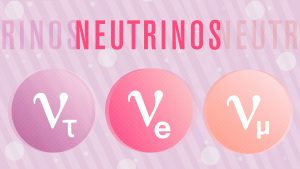by poet John Updike
They have no charge and have no mass
And do not interact at all.
The earth is just a silly ball
To them, through which they simply pass,
Like dustmaids down a drafty hall
Or photons through a sheet of glass.
They snub the most exquisite gas,
Ignore the most substantial wall,
Cold-shoulder steel and sounding brass,
Insult the stallion in his stall,
And, scorning barriers of class,
Infiltrate you and me! Like tall
And painless guillotines, they fall
Down through our heads into the grass.
At night, they enter at Nepal
And pierce the lover and his lass
From underneath the bed—you call
It wonderful; I call it crass.
A cavern tunneled in a circle
Beneath buffalo and prairies
Metal machines measuring cooling electric magnetic heat
Flinging you around and around
Whipping you around again and again
Pulling you apart
Pain stripping you from yourself
Paring you down
To a sliver so small
No one knew you could be so small
Too small for hollow
You are a ghost of yourself
Your heart beats
Still
Then suddenly they grasp you —
Torn tiny soul
And fling you in a straight line through the earth
No time to shiver
Blue green brown earth space
Dropping the unseeable you
Into a vat to accept
Your hot energy
What’s a neutrino?
 |
| Credit: Symmetry Magazine / Sandbox Studio, Chicago |
- Trillions of the harmless particle stream through you every second, night or day.
- They are the second most abundant particle in the universe (after particles of light called photons).
- Neutrinos rarely interact with anything—a lightyear of lead would stop only about half of the neutrinos coming from the sun.
- About 15 billion neutrinos from the Big Bang are in the average room.
- Neutrinos interact only through two of the four known forces: the weak force and gravity.
- So far, scientists have discovered three flavors of neutrinos: electron (νe), muon (νμ), and tau (ντ).
- They oscillate, or change flavor, as they travel.
- Their masses are very tiny, but not yet known.
- Their speed is very close to the speed of light, but also not known exactly.
- They could be the reason that matter exists in the universe.
Neutrino flavors
- electron neutrino (νe)
- muon neutrino (νμ)
- tau neutrino (ντ)
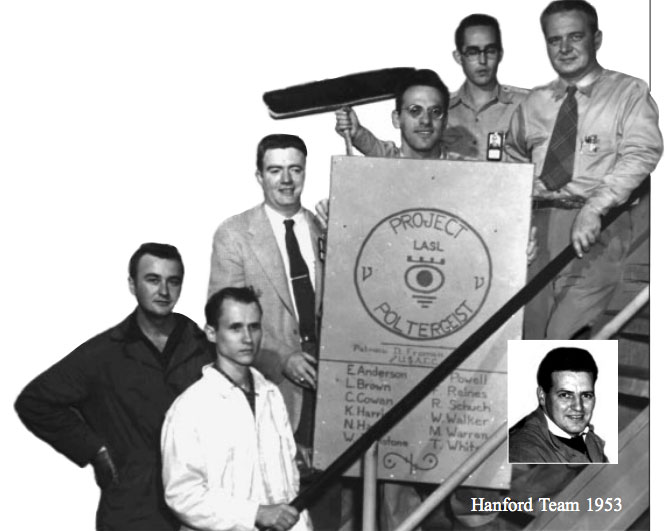 |
| The Project Poltergeist team led by Reines (holding sign) and Cowan (far right) was the first to experimentally detect the neutrino. | Credit: Los Alamos Nat'l Lab. |
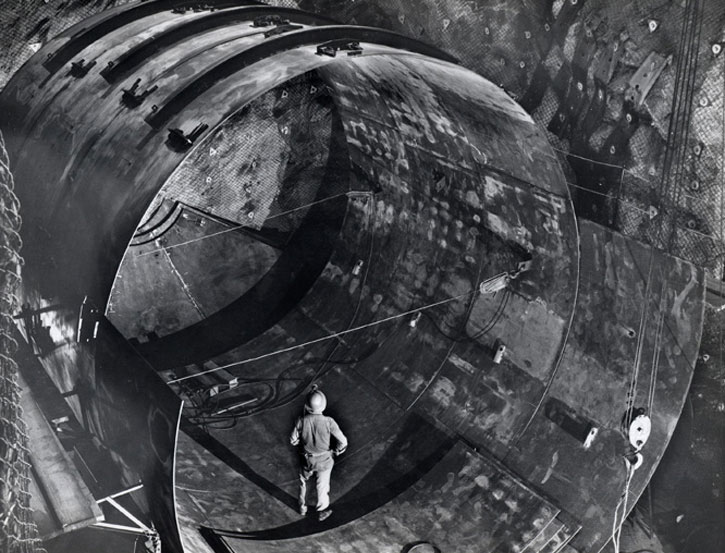 |
Ray Davis stands in the Davis Experiment at the Homestake Gold Mine in South Dakota | Credit: Anna Davis/Sanford Underground Research Facility |
Confusion arrived in 1968 with Ray Davis’s experiment in the Homestake Gold Mine in South Dakota. The project was designed to capture neutrinos coming from the sun, but about a third of the expected solar neutrinos ever arrived. Physicists called this “the solar neutrino problem.” It wasn’t until results from the 1998 Super-Kamiokande experiment in Japan (which looked at atmospheric neutrinos) and the 2001 Sudbury Neutrino Observatory in Canada (which looked at solar neutrinos) that physicists knew neutrinos were changing between flavors as they traveled. The solar neutrino problem was solved once scientists realized neutrinos oscillated into different flavors that the Davis experiment couldn’t detect.
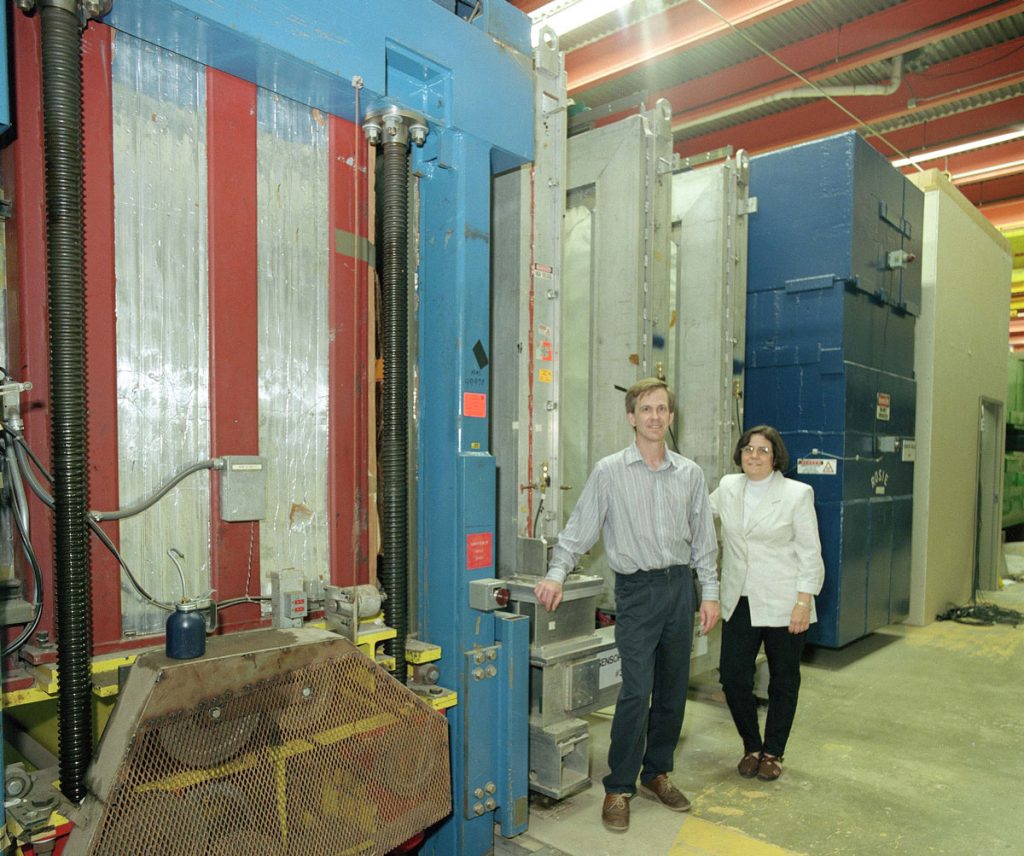 |
| Byron Lundberg and Regina Rameika stand in front of the E872 (DONUT) detector. | Credit: Fermilab |
 |
| The Standard Model of physics lays out the building blocks of matter: quarks, leptons, force carriers, and the Higgs boson. Credit: Fermilab |
Antineutrinos
Antimatter sounds like something cooked up for a science fiction story, but it is as real as you are. Matter is built up of protons, electrons, and neutrons, each of which has a mass and a charge (either positive, negative, or neutral). Antimatter particles look almost like their matter twins: They have the same masses, but they have opposite charges.

Credit: Symmetry Magazine/Sandbox Studio, Chicago
For example, the electron has a negative electric charge, and the positron (an antielectron) has a positive charge. An antiproton is a negatively charged proton. Antimatter particles such as antiprotons and positrons can get together to form antiatoms the same way protons and electrons form atoms. However, most of what we see in the universe is made of matter rather than antimatter. Scientists aren’t sure where all of the antimatter is, but hope experiments like the Deep Underground Neutrino Experiment will shed light on this issue in the near future. It is also possible to create antiatoms in a laboratory and study them, though this is very difficult to do. When matter and antimatter meet, they annihilate in a fiery burst of light.
An antineutrino is thus simply an “opposite version” of a neutrino. But if one of the main ways matter and antimatter are opposites is charge, then what does it mean that neutrinos are neutral? Does that mean neutrinos and antineutrinos are the same thing, only differing in the particles (positrons or electrons) produced along with them? Scientists aren’t sure. There are many experiments under way or proposed to discover whether that’s the case.
For now, scientists think of the three neutrinos (electron, muon, and tau neutrinos) and the three antineutrinos (electron, muon, and tau antineutrinos) as distinct particles.
Scientists are interested in antineutrinos for both practical and theoretical reasons. On the practical side, antineutrinos are produced in prodigious amounts in nuclear reactors, and these antineutrinos can be used to precisely monitor the reactor core. On the other hand, scientists want to study antineutrino oscillations and find out if neutrinos and their antimatter siblings behave in unexpectedly different ways.
An antineutrino is the antiparticle partner of the neutrino, meaning that the antineutrino has the same mass but opposite “charge” of the neutrino. Although neutrinos are electromagnetically neutral (they have no electric charge and no magnetic moment), they may carry another kind of charge: lepton number. These are defining features that can distinguish a particle from an antiparticle (along with properties such as helicity).
Family lepton numbers are assigned to the three families of leptons, which are easily remembered by their flavors. The electron and electron neutrino (and their antiparticles) are one set, the muon and muon neutrino are another, and the tau and tau neutrino make up the third. In the electron flavor, lepton number is described in terms of electron number; electrons and electron neutrinos get a value of 1, positrons and electron antineutrinos get a value of -1, and all the other leptons (associated with muons or taus) have a value of 0, because they have no electron flavor. The same happens in the muon flavor with a muon number: muons and muon neutrinos have the number 1, their antiparticles are -1, and everything else has a muon number of 0. Apply the same pattern for tau and the tau neutrino!
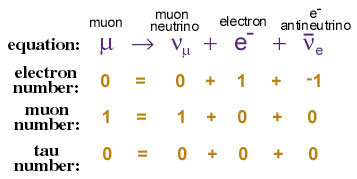
This example decay shows a muon transforming into a muon neutrino, an electron, and an electron antineutrino. Lepton number is conserved. Credit: The Particle Adventure/ Lawrence Berkeley National Laboratory
Scientists consider the total lepton number to be conserved if the summed family lepton flavor numbers before a reaction remain unchanged after a reaction. It’s a method of balancing the equations describing the reactions, and it’s a good predictor of whether scientists should expect a certain process to occur. So far, scientists have not observed violation of total lepton number conservation: they always see the appropriate numbers and types of neutrinos and antineutrinos being produced via the weak interaction. However, if neutrinos and antineutrinos are actually the same particle, the lepton number would not be conserved. Neutrinos may not have revealed the full story yet.
The fact that neutrinos oscillate from one flavor to another implies that family lepton flavor is not conserved. And if, for example, neutrinos and antineutrinos oscillate from one flavor to another at different rates, this would imply a violation of the so called charge-parity (CP) symmetry. That would be particularly exciting, because CP symmetry violation is a necessary requirement for going from a “neutral” universe (equal parts of matter and antimatter) to the matter-dominated universe we live in. This remains one of the greatest puzzles that particle physicists are trying to unravel.
Sterile neutrinos
Sterile neutrinos are a special kind of neutrino that has been proposed to explain some unexpected experimental results, but they have not been definitively discovered. Scientists are looking hard for them in many different experiments.
While the standard electron, muon, and tau neutrinos (and antineutrinos) interact with matter through two forces (the weak force and gravity), scientists think sterile neutrinos might interact only through gravity. This would make them even harder to spot than the tricky “regular” neutrinos. Gravity is the weakest of all the forces, and neutrinos are very light—so they don’t give gravity much to work with. Finding slight signals amidst the chaos of the universe will be tough, but not impossible.
While they know of the three flavors of neutrinos, scientists aren’t sure how many kinds of sterile neutrinos there might be. Is there just one to add in, or perhaps a parallel three? Or maybe there are even more!
---
Particles (including the wacky neutrino) have properties called spin and helicity. The particles don’t literally spin like a top, but this is still a good way of thinking about it. Helicity refers to how the spin relates to the movement of the particle, and it’s analogous to the idea of someone being left handed or right handed.
Hold out your hands and make two fists. The way your fingers curl represents a particle’s spin, and your thumb points in the direction of travel. These are right-handed and left-handed particles, and they’re important because one of nature’s four forces—the weak force—does not treat them equally. The weak force strongly prefers to interact with left-handed particles.
So far, scientists have found only left-handed neutrinos. But if there are right-handed neutrinos, they could be the predicted sterile neutrinos. Because the weak force would ignore them, sterile (right-handed) neutrinos would interact only through gravity, making them borderline invisible.
One way to discover these secretive particles involves oscillation. Some experiments have seen an excess neutrino oscillation where theory predicted they shouldn’t be. And some experiments have seen neutrinos appearing or disappearing over much shorter distances than the experiments on neutrinos from more distant locations, such as the atmosphere or sun. If neutrinos oscillate into this fourth kind of neutrino, that could explain the rapid changes and the anomalies seen in experiments. Much more data is needed before anything can be decided definitively.
Neutrinos interact through two of the four Standard Model forces: the weak force and gravity. It is this lack of interactions (and their tiny mass) that gives them their ghostly nature. For example, 50 percent of the neutrinos coming from the sun will pass through a light-year of lead without interacting.
But imagine a neutrino, already nearly massless, that does not interact through the weak force. How would scientists even know they were there? This is exactly the challenge with searching for “sterile” neutrinos.
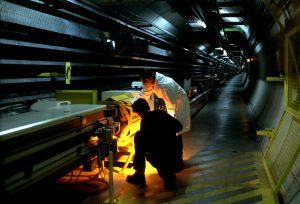
Technicians make delicate adjustments to one of LEP’s thousands of magnets in 1999. Credit: CERN
At the Large Electron-Positron (LEP) collider at CERN, scientists measured the particles that emerged from collisions between electrons and positrons. One particle, the Z boson, is the carrier of the weak force, and how quickly it decays depends strongly on the number of particles that it couples to. By measuring the decays of the Z boson, scientists were able to measure to a very high precision that only three neutrinos couple to the weak force: the electron, muon and tau neutrinos. But there could be any number of extra “sterile” neutrinos that LEP would be unable to see—though scientists would still need to figure out why.
The hints of sterile neutrinos come from a couple of experiments. The Liquid Scintillator Neutrino Detector (LSND) experiment at Los Alamos National Laboratory studied a decay-at-rest beam made of mainly muon neutrinos and found more electron neutrinos than they predicted. This was a similar signature of oscillation that had been seen for the known neutrino flavors, but at a distance and energy combination researchers weren’t expecting. A similar signal at a new location is a hint that an unknown kind of neutrino was hiding behind the scenes.
There is a lot of ongoing work to confirm if this interpretation of the LSND results is correct. So far the results have been inconclusive from these experiments. The MiniBooNE experiment at Fermilab saw hints that could also be interpreted as extra electron neutrinos appearing due to the existence of the sterile neutrinos, but the MINOS experiment, Daya Bay Reactor Neutrino Experiment, and other projects looking for neutrinos disappearing due to sterile neutrinos did not see that signal. The Short Baseline Neutrino program at Fermilab will use three liquid-argon detectors that are currently running or under construction. This suite of projects aims to definitively answer this question by making very high-precision measurements of a muon neutrino beam produced at Fermilab.
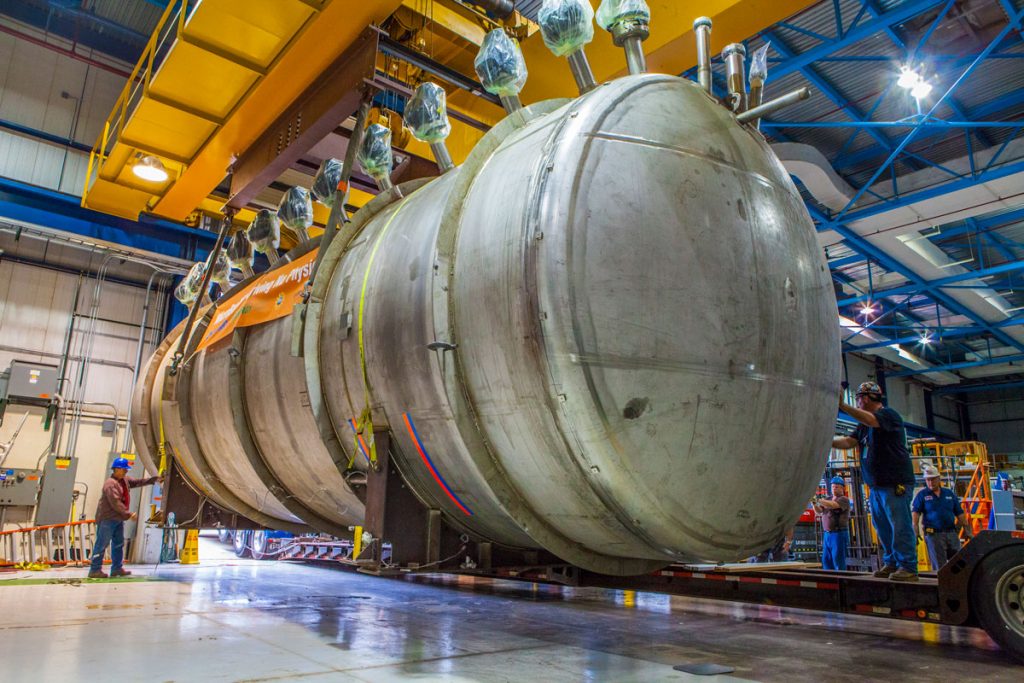
The MicroBooNE detector is one of the three short-baseline neutrino detectors at Fermilab. It is hunting sterile neutrinos and testing the liquid-argon technology that will be used for the enormous Deep Underground Neutrino Experiment. Credit: MicroBooNE/Fermilab
While the short-baseline experiments look for light sterile neutrinos carrying a relatively small amount of energy—at the electronvolt scale—there could be different sterile neutrinos at different energies. Sterile neutrinos around 1,000 electronvolts could be related to dark matter or other cosmological issues. And neutrinos around 1013 gigaelectronvolts could be the heavy seesaw neutrinos that help explain the small neutrino masses we see in the known light neutrinos. At just above this scale, 1015 gigaelectronvolts, physicists also start talking about grand unified theories and how different forces relate to one another.
So sterile neutrinos could tie into many different elements of physics. All neutrinos that scientists have seen so far are left-handed, and all antineutrinos are right-handed, but if there were right-handed neutrinos, they could act just like sterile neutrinos. Other particles have both left- and right-handed versions, and right-handed neutrinos are a popular way of adding neutrino masses into the Standard Model.
Neutrino masses
Physicists typically refer to neutrinos by their flavors: electron neutrino, muon neutrino, and tau neutrino. This makes good sense—when neutrinos interact in detectors, they typically produce their signature charged particle, making the neutrino flavor immediately obvious. Electron neutrinos interact to make electrons, muon neutrinos make muons, and tau neutrinos make taus.
But there is another way to think about neutrinos—their mass, or “mass state.” Physicists have named these neutrinos mass 1, mass 2, and mass 3, though they can also be referred to as ν1, ν2, and ν3. One might think that each of the three masses has a different flavor, but the truth makes matters more confusing: the mass state of a neutrino does not precisely match up with the flavor state of a neutrino.
A flavor of a neutrino (such as the electron neutrino) is made of a combination of masses (1, 2, and 3), and a neutrino of a certain mass (such as the lightest neutrino) has a certain probability of interacting in a detector to make a certain flavored charged particle (electron, muon, or tau).
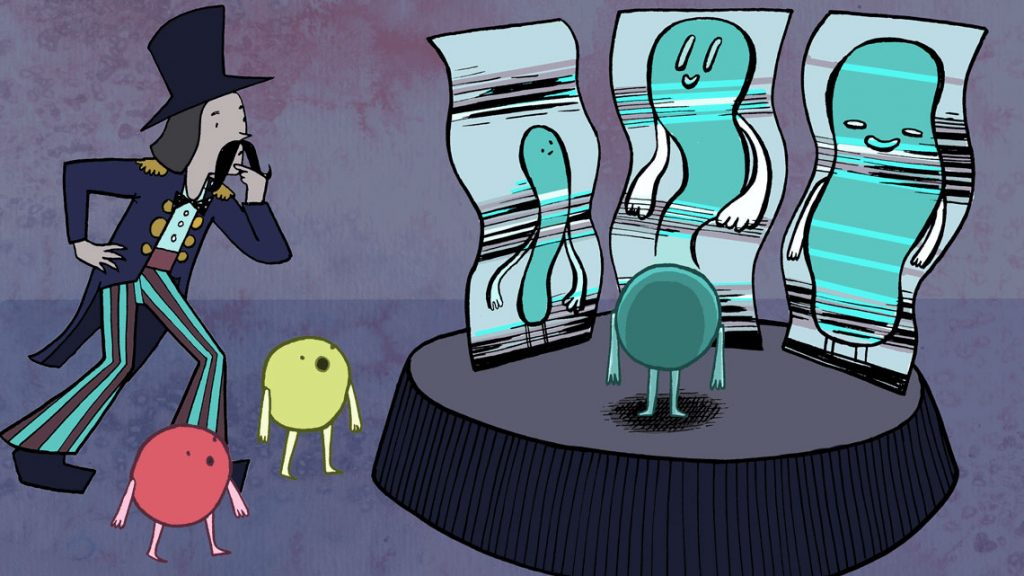
Credit: Symmetry Magazine/Sandbox Studio, Chicago
There are many open questions about the neutrino masses, but scientists do know a few things. They know that the masses of the three neutrinos are small. And they know a bit about how the flavor mixture for each mass neutrino breaks down. Mass 1 leans heavily toward electron flavor; mass 2 is more of an even blend of electron, muon and tau; and mass 3 is mostly muon and tau. And the masses of ν1 and ν2 are close to one another, while ν3 weighs either much more or much less than the other two.
---
Mass neutrinos and flavor neutrinos coexist in an interesting way. When a neutrino—let’s say an electron neutrino—is born, it is a quantum mechanical combination (or superposition) of all three mass states. Each particle is also a wave, and each has a slightly different mass, meaning each travels at a slightly different speed. As the electron neutrino travels, the different mass states get out of phase with each other; the lightest state has a slightly larger velocity than the heavier states. This causes the original mixture of mass 1, mass 2, and mass 3—which made up the electron neutrino—to change along the neutrino’s path. When the neutrino interacts again after a certain distance, it will have some probability of interacting as an electron neutrino, but it will also have a probability of interacting as either a muon or tau neutrino. Depending on how out of phase the mass states have become, the probability to interact as a muon or tau neutrino could be much greater than the probability to interact as an electron neutrino.
Here’s another way to imagine it: an epic food fight has broken out inside of an ice cream parlor. Your nearby friend slings a scoop in your direction, and it hits you right in your open mouth. You can easily identify the flavor as chocolate (and not vanilla or strawberry) the same way a detector can taste the incoming neutrino flavor (as an electron and not muon or tau neutrino). But something weird happened with that ice cream. It started in your friend’s hand as chocolate ice cream, and arrived in your mouth as chocolate ice cream, but on the journey in between, the ice cream turned into gold, silver, and copper coins.
These coins have different masses—just like the mass neutrinos, mass 1, mass 2, and mass 3. And because they weigh different amounts, they travel at slightly different speeds. Some of the gold coins start to fall behind a little bit, while the lighter copper ones fly a little further. You were relatively close to your friend when she threw the ice cream, so the coins didn’t separate all that much. Their ratio was basically unchanged when they reached you, and they transformed back into tasty chocolate ice cream once they reached your mouth.
Out of the corner of your eye, you see your friend throw chocolate ice cream on a long journey toward someone far across the store. The ice cream leaves her hand and POP: turns into a blob of coins. Over this long distance, the weight really starts to matter. The silver and copper coins arrive close together, and the gold coins a second later. PLOP. The ice cream lands in the target’s mouth, and he declares it tastes like strawberry. The ratio of coins making up the ice cream is different than when it started—and it turns out this affects the flavor.
If you had a pure mass state neutrino, it would consist of only gold coins, or only silver coins, or only copper coins. Because of the way things get really weird at small scales, these pure mass states would still have a probability of interacting as a certain flavor. That is, even if you had all gold coins, you still wouldn’t know for sure if the ice cream would taste like chocolate, strawberry, or vanilla when you detected it. But there would always be the same probability of tasting a certain flavor given a type of coin. In the same way, each of the pure mass state neutrinos has a different ratio of flavors it is likely to produce.
Neutrino physics is messy and delicious.
As if it weren’t confusing enough to have neutrinos of different flavors, different masses, and different matter (antimatter and regular matter), neutrinos also come in a wide variety of energies.
The energy of a neutrino depends on the process that formed it. Because neutrinos have no charge, there’s no way to use electric fields to accelerate them and give them more energy, the way scientists can do with particles such as protons. More energetic reactions will create more energetic neutrinos. These are great for scientists, because particles with more energy are more likely to interact and leave traces. They’re more likely to be stopped by regular matter and transfer that energy to something else (other particles) that detectors can pick up.
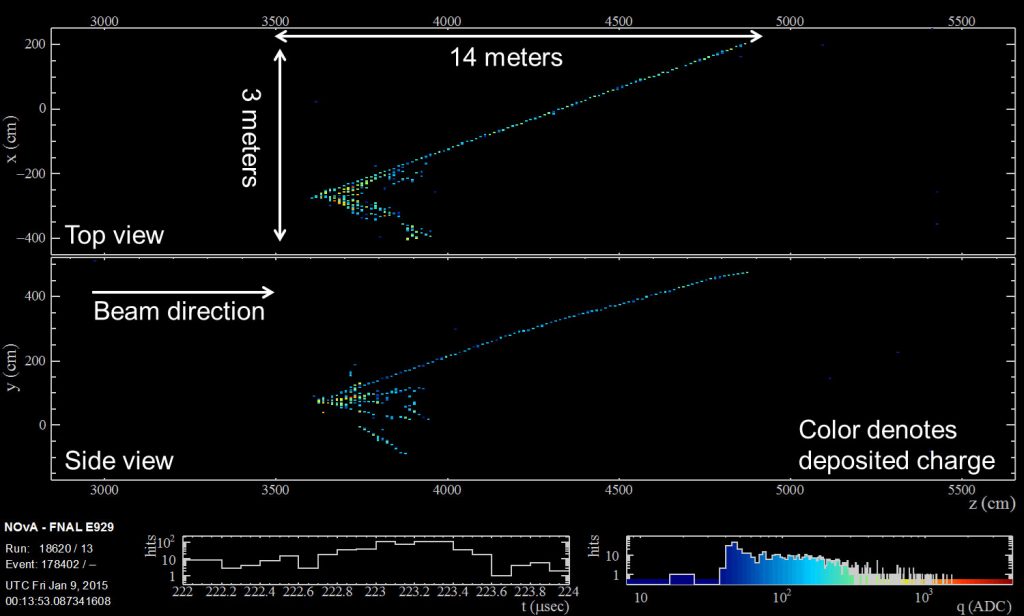
This track from the NOvA neutrino detector at Fermilab shows particles produced by a neutrino interaction. Credit: NOvA collaboration
Low-energy neutrinos, such as those left over from the Big Bang, are very difficult to find because not only are they weakly interacting (like all neutrinos), but they also don’t have much energy to pass on to other particles we can see. Even if they do, that signal is likely to be weak and hard to pick out from all the other interactions shouting over it.
Neutrino energy is typically measured in electronvolts. But there is a big range of neutrino energies. Some have one-millionth of an electronvolt, and some have a quintillion electronvolts (that’s a 1 followed by 18 zeros). That means plenty of neutrinos to explore, and interesting information about the processes that formed those neutrinos.
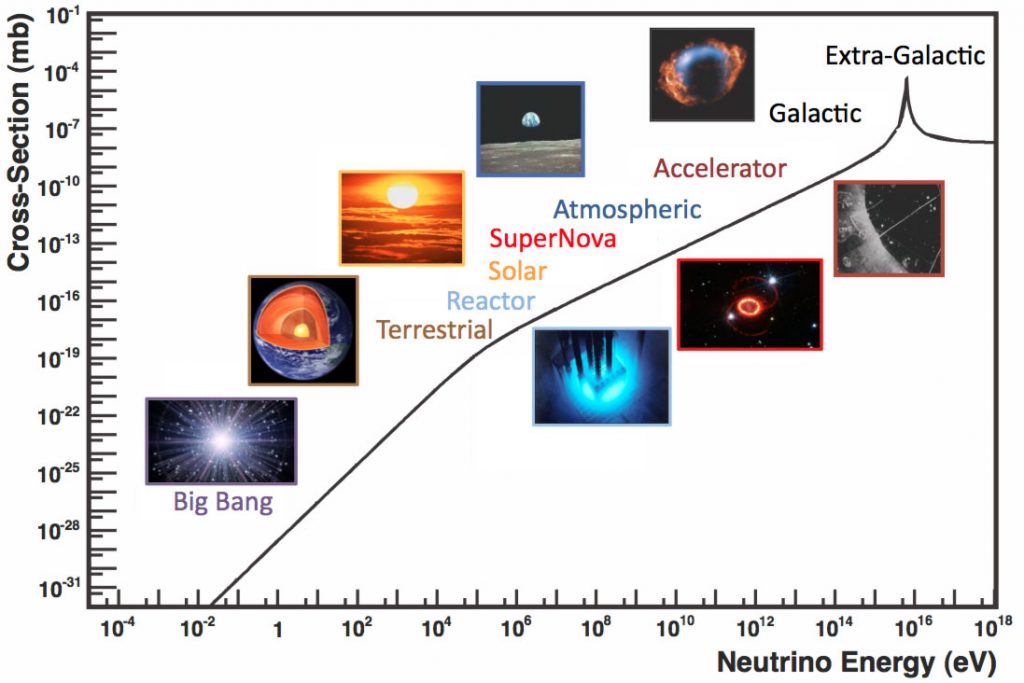
Neutrinos come in a wide variety of energies. Some of the lowest-energy ones come from the Big Bang, while the most energetic seen thus far have come from extragalactic sources. The neutrino cross section (on the y axis) is a measure of how likely the neutrino is to be stopped by regular matter. The higher energy a neutrino has, the more likely it is to interact. Credit: J.A. Formaggio and G.P. Zeller
---
Because neutrinos come in a very broad range of energies, an even broader range of techniques have to be used to see them.
The lowest-energy neutrinos come from just a few seconds after the Big Bang, and it is expected that these neutrinos have only a fraction of an electronvolt of energy. This is less energy than it takes to even knock an electron out of a hydrogen atom, making them incredibly hard to detect, because you need a detector with an even lower threshold. It turns out that materials at room temperature are vibrating with thermal energies that are much higher than these Big Bang neutrinos, so one way to see these lowest-energy neutrinos is to use stiller, colder materials (at cryogenic temperatures) and look for nuclei that receive a small amount of energy seemingly out of the blue. Another proposed method to see these neutrinos is using these low-energy neutrinos to stimulate a beta decay, then searching for an outgoing electron that has just a little more energy than one would expect. The trick, then, is building a detector that can measure tiny differences in electron energies.
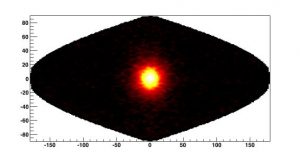
This plot shows the sun in neutrinos. The bright yellow at the center means a high concentration of neutrinos from that direction. Credit: Super-Kamiokande Collaboration/Kamioka Observatory, ICRR, Univ. of Tokyo
Neutrinos from the sun come in energies from tens to millions of electronvolts, a result of the many different fusion processes that take place there simultaneously. Scientists now know that most neutrinos from the sun are in the tens to hundreds of electronvolts. Researchers were able to see these only by building an extremely large scintillator detector and making sure there were no radioactive contaminants anywhere nearby.
The first neutrinos from the sun that scientists were able to see were the ones energetic enough to change a chlorine atom into an excited argon atom (by changing a neutron inside a nucleus to a proton). The was Ray Davis’s experiment at the Homestake Gold Mine. By measuring the radioactive decay of that excited argon atom, scientists made the first measurements of neutrinos from the sun.
Once a neutrino is energetic enough to knock an electron out of its orbital, then detectors that are sensitive to electric charges can pick the little particles up. The striking thing about this reaction is that the electron is knocked out of its orbital at exactly the same angle as the incoming neutrino hit with. If a detector can measure that outgoing electron angle and take into account the detector’s relationship to the sun, then you can actually “see” the sun with neutrinos. The detector, whether it’s on Earth’s surface or underground, will see the sun all the time, day or night.
Neutrinos from nuclear reactors have a million times more energy than Big Bang neutrinos, so they can be seen by measuring their interactions with atoms. One key difference is that the neutrinos from reactors are actually antineutrinos, so instead of changing neutrons to protons, they change protons to neutrons—and the neutrons are much harder to detect. The neutrons can be captured by certain particles that then decay and produce photons, particles of light, which can signal that a neutrino was there.

The Deep Underground Neutrino Experiment hosted by Fermilab will use an intense beam of neutrinos with billions of electronvolts of energy. Credit: DUNE/Fermilab
As neutrinos go from a million electronvolts to a billion electronvolts, they can start to transfer more energy to the particles in a detector. At a billion electronvolts, that same process of a neutrino colliding with a nucleus can produce an electron that travels through dozens of centimeters of plastic or a muon that travels through meters of steel. At 10 billion electronvolts, the neutrinos have enough energy to completely break up a nucleus.
Finally, if you need a meter of steel to see a 1-GeV muon, then you need a kilometer of steel to see a 1-TeV muon. The detectors that have seen the highest-energy neutrinos are those that are made with a cubic kilometer of detector material. The question is, how on Earth can you afford a cubic kilometer of detector? You have to use some material that’s already available in large quantities and figure out how to pull a signal out of it. People have made detectors out of both ocean water and the ice in Antarctica to see these highest-energy neutrinos.
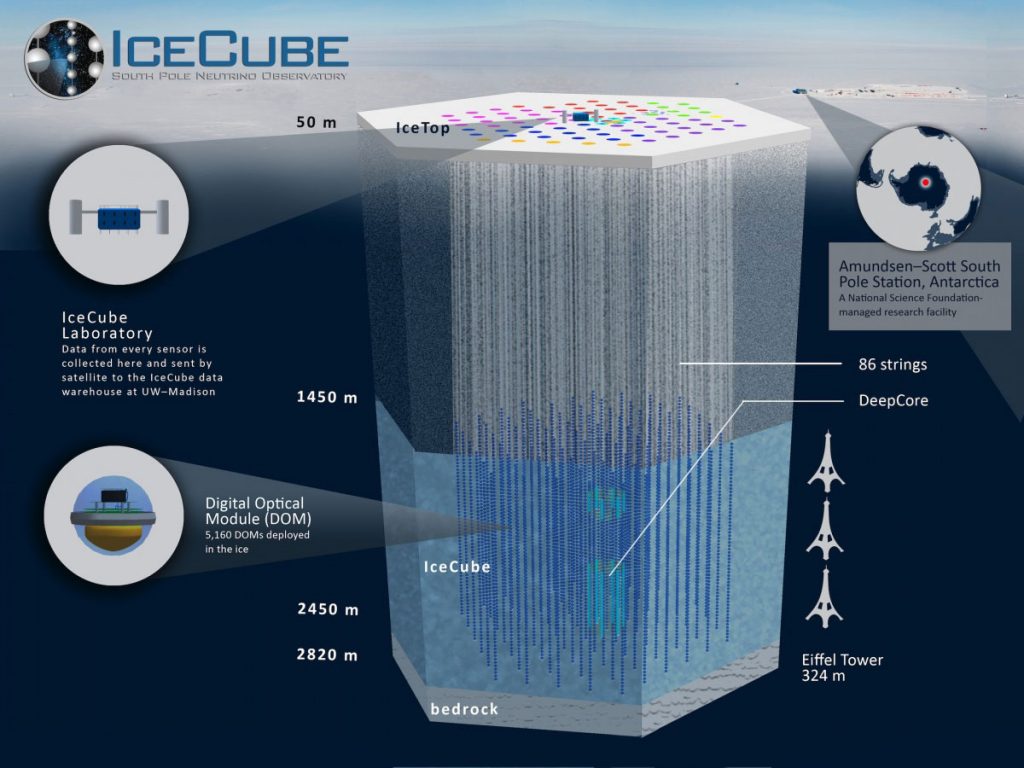
The IceCube experiment uses a cubic kilometer of ice in Antarctica as its detector medium. More than 5,000 sensors in the ice look for neutrinos from outer space. Credit: IceCube Collaboration/University of Wisconsin-Madison







